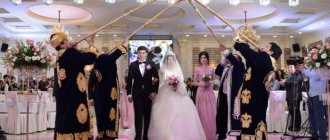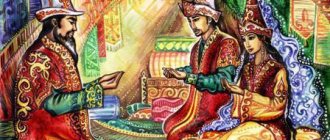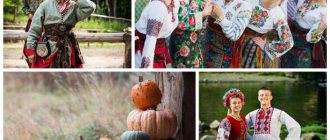Lezgin weddings are famous for their scope, effervescence, and unbridled fun. Throughout the entire holiday, young people compete with each other in agility and dancing skills, measure their strength, and prove their courage to others. It would seem that everything here breathes lightness, but in fact, Lezgin weddings are a very serious and responsible event, a solemn event, the decision to organize which was made long before the holiday itself.
The young man informed his father about his desire to get married through his friend. Having received such news, the relatives gathered at a family council and discussed in detail the candidacy of the prospective bride. If everyone present agreed that the young man had chosen a worthy girl, then matchmakers were sent to her parents’ house.
Lezgin wedding in the village - traditions and customs
Lezgin weddings are famous for their scope, effervescence, and unbridled fun.
Throughout the entire holiday, young people compete with each other in agility and dancing skills, measure their strength, and prove their courage to others. It would seem that everything here breathes lightness, but in fact, Lezgin weddings are a very serious and responsible event, a solemn event, the decision to organize which was made long before the holiday itself. The young man informed his father about his desire to get married through his friend. Having received such news, the relatives gathered at a family council and discussed in detail the candidacy of the prospective bride. If everyone present agreed that the young man had chosen a worthy girl, then matchmakers were sent to her parents’ house.
Language
Georgian is recognized as the official state language of the country, but the linguistic map is quite colorful and diverse. In the vastness of Georgia, you can hear many unique dialects and dialects characteristic of a particular territorial area.
Forming the basis of office work, folk literature, music and the media, Georgian is the native language of only 80 percent of the population. In the northern regions, the Abkhaz language culture predominates, and on the borders with Kabardino-Balkaria - Svan. The largest linguistic minority of Georgian culture is the Mingrelian language group. According to official statistical reports, over five hundred thousand residents speak this dialect. Each language of Georgia has a printed media.
How does matchmaking and engagement work?
Most often, boys and girls are engaged in early childhood, but if this happens at an adult age, then the bride is simply showered with expensive gifts. The main gift is a wedding ring made of silver or gold.
Betrothal is a ritual during which those accompanying the groom or his representatives come to the house of the bride's parents with gifts intended for the girl and refreshments for her parents and relatives. The parties previously agreed on the amount of the bride price, which had to be collected before the appointed date.
On the day of the engagement, the girl's father received numerous guests in his house. It could be the future groom himself or his father, uncle, brothers and closest relatives. The elder representatives of the clan could conclude an agreement. If the answer was positive, an expensive ring was put on the bride’s finger. From this moment until the wedding day it could take from a year to five or more years.
During this time, the young people did not see each other and did not communicate. There have been cases when the bride and groom, engaged in infancy, knowing about each other’s existence, met for the first time only at their own wedding.
Dargins
Dargins are the people of Dagestan, traditionally inhabiting mountainous regions. There is no language that unites all Dargins; there are many variations of the Dargin language. The customs and traditions of the peoples of Dagestan, as well as the Dargins individually, are closely connected with the general social and economic processes that took place in the ancient period of history. They were engaged in the usual activities for the inhabitants of this territory, that is, cattle breeding, agriculture and folk crafts. The Dargins were famous for their jewelry, leather and wool products, and weapons. Women processed wool, wove cloth and rugs.
Celebration
The wedding lasts several days. The richer the families, the longer the holiday lasts. On the first day, according to tradition, three musicians were received at the groom’s house, who were presented with gifts in the form of:
- three pairs of socks;
- three scarves;
- three bread cakes.
The second day is the day of the wedding ceremony. Guests and relatives gathered at the house of the groom's parents and brought gifts for the newlyweds. The groom's friends, witnesses, qadi and mullah entered the room where the newlyweds, the bride's father and uncle were waiting for them. They asked the bride and groom if they agreed to tie the knot, read a prayer, and performed the marriage ceremony. After this, the boy and girl were called husband and wife. On the third day, the girl left her parents' home and moved to her husband's house.
Here she was met by her mother-in-law with a little boy in her arms (according to legend, the girl who took the baby in her arms was supposed to be the first to give birth to a son).
To ensure that life was sweet and happy, and that the mother-in-law and daughter-in-law did not argue or quarrel, the groom’s mother treated her daughter-in-law with honey.
The girl had to eat a spoonful of honey from her mother-in-law's hands. She had no right to refuse. Young Lezgins and Lezgins had fun at weddings separately.
Modern youth celebrate in the same room of a restaurant, and girls and boys dance in the same circle, but previously it was strictly forbidden for women to be in the same room with men even during the holiday. Traditional dance – lezginka. It is danced by boys and older men, demonstrating their dexterity during the dance.
If the bride takes part in the dance, then the groom’s relatives should appreciate the smoothness of movements and the ability to emphasize the partner’s advantages while remaining in the shadow of the man.
Ancient Rus'
After Christianity became the official religion in Kievan Rus, the formation of a traditional wedding ceremony began.
Since it was not possible to completely eradicate paganism, a symbiosis of Christianity and pagan rituals resulted. After the 16th century, a clear ritual, wedding dresses, attributes and folklore developed, which have survived to this day. And the main innovation was the mandatory church consecration of marriage.
The ceremony took place in the evening, for which they put on the best dress and all the jewelry that was available. In the front door they prepared a table at which they awaited the arrival of the groom. Then the mother-in-law combed her hair and braided two braids, which symbolized a woman in marriage. After the blessings, the newlyweds went to the wedding; according to the rules, the groom had to arrive first. Only after the wedding could the couple kiss. When leaving, the newlyweds were showered with hops and flax seeds, with wishes of happiness. Afterwards, everyone headed to the husband’s house, where the celebration itself took place.
The ceremony itself was divided into several stages: pre-wedding customs (dating, bride viewing, maiden fortune-telling); pre-wedding customs (matchmaking, bridesmaids, collusion, bachelorette party, groom's gatherings), wedding rituals (bride ransom, wedding train, wedding, wedding feast) and post-wedding rituals (second day, visits).
After the wedding
After the celebrations are completed, the groom takes the young bride and goes with her to his parents' house.
The wedding night is a sacred sacrament, after which the groom's mother and aunts must receive visual confirmation of the bride's innocence. On the morning after the wedding night, the bride's parents were told that the girl was indeed chaste, and the celebration continued.
Only on the third day did the now young wife leave the room and meet the guests on the threshold of her new relatives’ house. She gives each person a personalized gift.
Lezgin wedding. Traditions. Part 1.
Among all the nationalities of the Lezgin group, the initiative in marriage was shown not so much by the young man himself, but by his parents and close relatives. Among the Tabasarans, for example, a young man conveyed his desire to get married to his parents through his friend. Before marrying their son, the parents should have known about his choice, also through a close friend. Then the relatives gathered for a council, where they discussed the advantages and disadvantages of the family of the prospective bride. The decisive word belonged to relatives respected by age. After family council, the groom's parents officially instructed their closest relative (male or female) to obtain the consent of the bride's parents. The matchmaker (or matchmaker) came to the bride's house several times, and only after the third visit did the intermediary receive consent for the engagement. In the languages of the Lezgin group, matchmakers were called “ilchi.” The matchmaker came to the bride's house with two ritual breads. If the girl’s mother agreed to the marriage, then she accepted the bread brought. The opposite meant refusal. The mistress of the house received guests, placed tea and sweets in front of them. However, before touching the food, the “ilchi” announced the purpose of their coming.
Only after receiving consent did they partake of the meal. Etiquette did not allow one to openly reject the offer. The refusal was given in a polite form (“We did not think about marrying our daughter”, “The time has not yet come”, etc.). The decisive word belonged to the father. He could have given his daughter away against her wishes. Often the reason for parents' disagreement with marriage was the social inequality of families.
Among the coastal Lezgins, especially among the Azerbaijani, the bride price was known as “kalyma”; among the mountain Lezgins of Dagestan it was known as “rushen rag”. Among the Lezgins, most families most often did without collecting a ransom and limited themselves to purchasing a set of wedding clothes for the bride and a small sum (meire), provided for by Islamic Sharia law. The higher and deeper into the mountains, the rarer the bride price was. Payment for the bride was most clearly reflected in adats. Adat also provided for the following situation: if a man, wooing a girl from another family, agreed to marry his sister to one of the members of the same family, then he did not pay “yol-puli” (conditional fee), and this exchange was called “bash- basha" (Az. head by head). If during this matchmaking the girl of one party did not reach the age that allowed her to get married, then her side paid extra according to the condition to the family from which the adult girl was taken. Usually the bride's dowry exceeded the amount contributed by the groom. Often the father of the bride gave his daughter cattle or a plot of land as a dowry. Even the average peasant, when sending a girl’s dowry, tied a cow to a cart, saying: “This is for her.” The collection of a bride price - "kalym" - in most cases was observed in the families of the wealthy elite of the Lezgin group of peoples. The bride price was paid not only in money, but also in kind: grain, sheep, and cattle. In addition to the bride price, the groom was obliged to buy his future wife a wedding silk outfit, one pair of everyday clothes and a pair of boots or shoes.
After accepting the proposal, the groom's parents invited close relatives who came with gifts, and the most respected of them went to the bride's house for the final agreement. The gift to the bride consisted of a ring (silver or gold, silk scarf, dresses, socks, shoes, national dish pilaf, sweets). On the evening of the conclusion of the deal (betrothal), the wedding day was set. 2-3 days after receiving the deposit, the groom’s parents, through their relatives, gave the bride’s parents the rest of the bride price. On this day, there were refreshments in both the bride's house and the groom's house. One representative from each sakli of the aul was invited to the groom's house.
In addition to the kalym, the marriage contract provided for “kebin gak” - money (no more than 40 silver rubles) to provide for the wife in case of divorce. Having finally agreed, both parties - relatives of the bride and groom - congratulated each other. At this point the betrothal was considered completed. In some families, a special day was appointed for the betrothal (“lishanar”), and the day before it, all the relatives with gifts or money gathered at the groom’s house. The groom's parents selected the necessary gifts, equipped trays (hunche) with clothes, sweets, and pilaf. On the appointed wedding evening, the groom's delegation went to the bride's house with music, men in front, and women behind them with gifts. They were met by the bride's parents. In honor of their arrival, food and dancing were held. Accepting the gifts brought and part of the agreed portion of the ransom, putting a ring on the bride’s finger (“nishan”) meant the completion of the betrothal ceremony and the bride was considered finally betrothed.
Agultsy
The Agul people of Dagestan live in its southern part. The size of this population is approximately 8-9 thousand people. To communicate, they use the Agul language, which is related to Lezgin. This nation lives in 21 settlements in southeastern Dagestan.
The traditions of this people, like the traditions of the peoples of Dagestan in general, are unique. For centuries, the main occupation for the Agul people was cattle breeding. Only men had the right to care for sheep. Women worked exclusively with cattle.
Metal processing was a very important aspect of the life of the Agul people. Blacksmiths made axes, scythes, knives and sickles, which were useful in any household. The Agul people were excellent builders. They built bridges, houses and mosques. They decorated their buildings with skillfully carved stones, the ornaments of which reflected the entire culture of the peoples of Dagestan.
Matchmaking
A young man, having decided on the choice of his betrothed, must tell his family about this decision. But he himself does not report this; either his brother or a friend does it for him. A home meeting is scheduled, at which a decision is made whether the girl is worthy of being at home. If the council makes a positive decision, the matchmaking process begins.
A venerable Lezgin is sent to the bride's parents, who is entrusted with the mission of asking for a hand and heart. Ilchi or the matchmaker offers the girl’s mother three times to marry her ward. And only the third time the parents make a decision. The positive answer is the specially baked bread that she presents to the matchmaker.
Agreement
After mutual agreement of the parties, a second home council is held with invited relatives. Guests gather and give gifts and choose a delegation that will negotiate the nuances of the upcoming event.
They come to the future family's home with gifts for the chosen one - an engagement ring, a couple of outfits, shoes and treats - this is the initial advance before the bride price. After discussing the terms of the wedding ceremony, the rest of the ransom is sent a few days later. On these days, festive dinners are held in both houses, where all relatives are convened, and whose neighbors are notified of the future event. After this, the engagement is considered completed.











